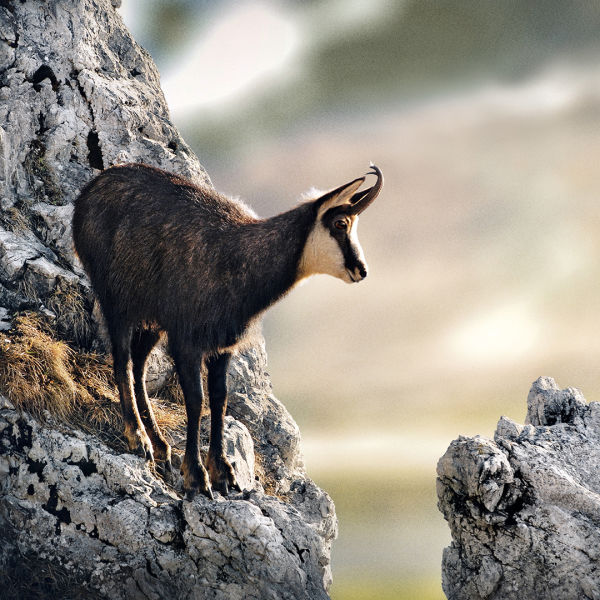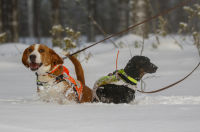From Black Grouse to Pronghorn and White-tailed deer: Numerous game species roam the natural landscapes of our planet. We invite you on a short excursion into the fascinating wilderness of Europe and North America and introduce you to 10 game species in more detail. Each month we put one animal in the spotlight. So clear the stage...

January: Central Europe
Wild boar
The wild boar is one of the most formidable game species in Europe. In European stories and legends, the wild boar often symbolizes resilience, strength, and bravery. When a group of wild boar, also called a singular, breaks in the ground, it causes severe damage, especially to agriculture. In addition, the intelligent wild boar is extremely adaptable and has very high reproduction rates. This is why hunting pressure on wild boars is increasing in many parts of Europe. To meet the hunting quota, thermal imaging technology is gaining importance in many places.

February: Alpine region
Rock Ptarmigan (Lagopus muta)
The Rock Ptarmigan (Lagopus muta) is a relic from the Ice Age. The ancestors of these grouse came from the Arctic to the Alpine region during the Great Ice Age. In winter, the ptarmigan often lets itself be snowed in for several days. Thanks to the insulating effect of the snow, temperatures inside the "igloo" hardly fall below freezing point, even when temperatures outside the cave are in the double-digit minus range.
However, rising temperatures in combination with small amounts of snow will give the Rock Ptarmigan a hard time, especially if the white plumage does not change to the brown "summer mode" in time. Then it becomes an easily detectable target for birds of prey.

April: North America
Wild turkey (Meleagris gallopavo)
Turkeys have been around for about 10 million years. They are only native to North and Central America. The species in North America Wild Turkeys are broken down into five subspecies:
Eastern Wild Turkeys (Meleagris gallopavo silvestris)
Osceola or Florida Wild Turkey (M. g. osceola)
Rio Grande Wild Turkey (M. g. intermedia)
Merriam’s Wild Turkeys (M. g. merriami)
Gould’s Wild Turkey (M. g. mexicana)
The only subspecies that can be found only in Central America is the Ocellated Turkey (M. g. gallopavo).
Despite their corpulent bodies, turkeys can run as fast as 25 mph and fly as fast as 55 mph.

May: Austria
Black Grouse (Lyrurus tetrix)
The Black Grouse (Lyrurus tetrix) is thesmaller cousin of the Western Capercaillie (Tetrao urogallus). It can be found in open, structurally rich landscapes in Central Europe. However, due to various encroachments on its habitats and growing recreational activities of humans, it is becoming increasingly rare to find.
The breeding success after the impressive, loud courtship depends on the weather in June and July. The Black Grouse feeds primarily on plants, but the chicks need animal protein in the first few weeks to grow quickly. If it is still too cool or there is still snow at this time, the chicks will not get the nutrition they need and may freeze.

July: Central Europe
Roe deer
When roe bucks sweep their antlers in the spring to mark their territory, they prefer to choose the tree species that occurs least frequently in their territory. After mating in July/August, the overall gestation period lasts up to 300 days, thanks to a phenomenon called diapause.
When the doe then set their fawns in cultivated fields in May/June, this presents farmers with major mowing challenges. In many countries, the hunting community therefore carries out fawn rescues on a voluntary basis.
Insights into the drone-assisted fawn rescue in Switzerland can be found below.

August: North America
Pronghorn
The pronghorn is often called pronghorn antelope because of its appearance, although it is not an antelope. They are closer related to giraffes and okapis. Pronghorns are the last remaining representatives of the genus of pronghorns (Antilocapridae).
After the cheetah, the pronghorn is the fastest land mammal on earth and can run at speeds of up to 60 mph (95 kmh). Pronghorns can sustain this speed for more than five kilometers. They developed these running skills while still living with and running from the now extinct American cheetahs in North America.

September: North America
Elk
The name "Wapiti" originates from the language of the Shawnee Indians and means something like "white rump". In North America, Wapitis are almost exclusively referred to as "Elk". In Central Europe, however, the deer species is known as Wapiti. To make the confusion perfect, when a person from Great Britain talks about the "elk", they are not talking about the wapiti, but about the deer species which is called "moose" in North America. Easy, right?
North America: Elk = Wapiti
Great Britain: Elk = Moose
Europe: Wapiti
An exciting story about wapiti hunting in New Zealand is told by hunter and TV producer Willie Duley.

October: North America and Finland
White-tailed deer
The White-tailed deer is one of the most popular huntable game species in North America. Since 1934, they have also been native to Europe, in Scandinavian Finland. How did it come about?
In the first half of the 20th century, big game in Finland was on the verge of extinction. A member of the Finnish Hunting Association finally had some White-tailed deer from America settled on his own land in Pirkanmaa. Today, more than 80,000 animals live in the southwestern third of Finland. The hunting of White-tailed deer in Scandinavia is mainly performed in the form of slow driven hunts.
Read more about White-tailed deer hunting in Finland in this article.

November: Central Europe
European mouflon
Mouflons are the smallest representatives of the wild sheep and at the same time the only wild sheep species that lives in Europe. Originally, mouflons stem from the mountainous regions of Central Asia. The first specimens were probably brought by man to the Mediterranean islands of Corsica and Sardinia.
Today, mouflons are widespread in Central Europe. In contrast to the goat-like chamois or ibexes, mouflons are not particularly talented climbers. However, they can jump up to 10 feet (3 meters) almost effortlessly from a standing position.
A delicious recipe suggestion for the game of the European mouflon can be found here.

December: Alpine region
Chamois
The chamois is one of the most important game species to be hunted in the Alpine region, especially in Tyrol, Austria. The climbing artists feel at home in the high alpine region. When fleeing from enemies, chamois rely on their extraordinary climbing skills. This is made possible by the unique shell structure, with a hard outer rim and elastic pads in the middle.
During the rut, spectacular chases take place over the steep terrain. If there are too few mature bucks in the herd, these chases often take place in excess and can end fatally for some chamois bucks. Not least for this reason, special attention must be paid to the age structure of the chamois population.
Numerous tips for the special challenges in mountain hunting can be found in this article by Thomas Hofer.




















